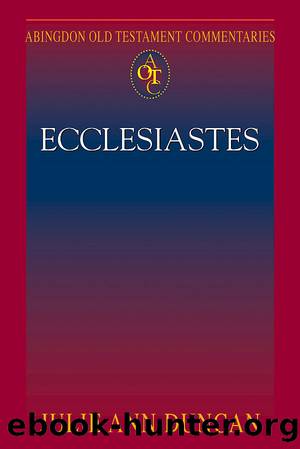Abingdon Old Testament Commentaries: Ecclesiastes by Duncan Julie Ann;

Author:Duncan, Julie Ann;
Language: eng
Format: epub
Publisher: Abingdon Press
Published: 2017-08-15T00:00:00+00:00
ECCLESIASTES 6:10â7:14
Prodding the Pupil
Literary Analysis
This segment comprises two subunits, 6:10-12 and 7:1-14. That 7:1 begins a new subunit can be seen in the shift in literary form to that of the proverb. For this reason, several commentators treat the prose segment of 6:10-12 as an independent section. It is true in fact that there is no tight organic relationship between these two units. The choice to assign 6:10-12 and 7:1-14 to the same exegetical unit is based on certain verbal and thematic connections between 6:10-12 and the final verses of chapter 7. Verses 13 and 14 of chapter 7 are in fact a reprise of ideas presented in 6:10-12.
Ecclesiastes 6:10-12 dwells on the limitations of humans. God is never explicitly named in the passage, but each assertion expresses a contrast between Godâs power and human finitude. This theme of human limitations and a powerful God who is beyond human reckoning is resumed in 7:13-14. Here God is explicitly named. Godâs work is described as a crooked thing that humans cannot make right. This crooked divine activity is seen in the oscillation of fortune and adversity in a human life. Such occurrences are beyond human control. A verbal echo in 7:14 further reinforces the thematic inclusio of human finitude in these frame passages: âGod has made the one as well as the other, so that mortals [ʾÄdÄm] may not find out anything that will come after them [ʾaḥÄrÄyw].â In 6:12 Qohelet states a similar idea in the form of a question: âFor who can tell them [ʾÄdÄm] what will be after them [ʾaḥÄrÄyw] under the sun?â The precise meaning of these two statements as they relate to their immediate context is in question. Nonetheless there is a discernable verbal play between them and, no matter how they are read in their specifics, both declare the problem of human ignorance in one form or another. For statements with similar wording and to similar effect, see 3:22 (humans cannot know what occurs beyond death), and 10:14 (humans do not know what will happen in the future).
Ecclesiastes 7:1-14 is the first of three collections of proverbs in the book (see also 9:17â10:4 and 10:8â11:4). A proverb is an artfully constructed literary vehicle for imparting instruction. As a literary form it may be highly compactâmuch is said in few wordsâcreating a kind of riddle that stirs the reader into active reflection on its meaning. The proverb expresses some truth, entailed in which is a guideline for behavior. Nonetheless proverbs are not intended as universal truths or timeless absolutes. They have a limited applicability. A proverb that is appropriate in one situation may have no currency in another (thus one finds proverbs in the wisdom tradition that are in direct contradiction). It is useful to keep this general orientation in mind as one approaches the proverbs transmitted in these sections, some of which appear to cohere with Qoheletâs broader ideas, and some of which do not.
The epilogist at the end of the book, in paying tribute to Qohelet the sage, gives an informative description of the responsibilities of the sage.
Download
This site does not store any files on its server. We only index and link to content provided by other sites. Please contact the content providers to delete copyright contents if any and email us, we'll remove relevant links or contents immediately.
Fangirl by Rainbow Rowell(8808)
How to Bang a Billionaire by Alexis Hall(7941)
Wonder by R. J. Palacio(7750)
The Space Between by Michelle L. Teichman(6589)
The Thirst by Nesbo Jo(6458)
Assassin’s Fate by Robin Hobb(5867)
Wiseguy by Nicholas Pileggi(5335)
The Night Circus by Erin Morgenstern(5044)
The Kite Runner by Khaled Hosseini(4963)
Paper Towns by Green John(4815)
Bittersweet (True North #1) by Sarina Bowen(4720)
Gerald's Game by Stephen King(4386)
Too Much and Not the Mood by Durga Chew-Bose(4105)
Pillow Thoughts by Courtney Peppernell(4035)
Goodbye Paradise(3464)
Twelve Days of Christmas by Debbie Macomber(3421)
Good by S. Walden(3361)
The Rosie Effect by Graeme Simsion(3223)
The Cellar by Natasha Preston(3081)
